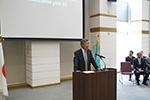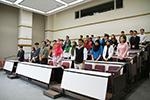2015/10/06
On Friday, October 2, 2015 , an entrance ceremony was held in the Training Hall on the 1st floor of Interdisciplinary Frontier Research Complex No.2.
NAIST eagerly promotes admission of students whether from Japan or overseas with strong basic academic capabilities without being bound to a major field in university as well as researchers, engineers and others currently working actively in society who have clearly defined goals and aspirations for the future as well as strong interest and enthusiasm for research fields. This autumn 45 graduate students were granted admission to NAIST.
*Number of Enrollees in October
【Master's Course】
Information Science 9 (9 international students)
Biological Sciences 5 (5 international students)
Materials Science 4 (4 international students)
【Doctoral Course】
Information Science 10 (7 international students)
Biological Sciences 9 (9 international students)
Materials Science 8 (6 international students)
Total 45 (40 international students)
Congratulatory Remarks to New Students
October 2, 2015
First of all, I would like to express my heartfelt congratulations to our 18 master's and 27 doctoral students who entered Nara Institute of Science and Technology, or NAIST, today. On behalf of the 200 faculty and 150 staff members of NAIST, I welcome you all.
I am pleased to announce that the incoming class represents 40 students from 7 countries and regions. I would like to express my warm welcome to those who have decided to leave home countries and study in Japan.
A week ago, we conferred doctoral and master's degrees to 19 international students. With our 40 new students who joined NAIST today, we now have 207 international students, from 38 countries and regions, from 5 continents, accounting for 19% of our 1,073 students.
Japanese universities had a tendency to limit their focus on domestic agenda. However, we now face growing demands on globalizing university to welcome people from abroad, as well as to raise the presence of Japanese science, technology, and culture in the world.
A further aim of globalized university is to expose Japanese students to diverse sociocultural values and familiarize them with social issues and needs that challenge science and technology in global society today.
Japan's Ministry of Education, Culture, Sports, Science and Technology (MEXT) launched the "Top Global University Project" in 2014. I am pleased to inform you that NAIST has been selected as one of the recipients for this prestigious program.
This project will help NAIST provide excellent learning and living environment where students with diverse cultural backgrounds will learn from each other about how science and technology can respond to pressing issues in global society.
Now I would like to introduce the background of NAIST's foundation. NAIST was established in October 1991, as an independent graduate university of a new kind.
In the establishment of NAIST, several key ideas were put forth as the mission of our institution.
The developing frontier science and technology, including information, biological, and materials sciences, are (1) being wide-ranging and interdisciplinary, (2) gaining new insights from fundamental research, (3) applying new knowledge of fundamental research to technological advancement, (4) creating opportunities for further fundamental research by new technology, (5) thus, being evident in integration of science and technology.
It is extremely important to keep in mind that the frontier science and technology should be promoted based on a more interdisciplinary approach, rather than on traditional, narrowly focused academic divisions.
The following is also stated concerning education:
Especially in these fields, it is necessary to train human resources that can respond flexibly to developments in science and technology and are capable of continuously pursuing new research fields.
In other words, NAIST was founded to conduct interdisciplinary research, integrating science and technology, extending past established areas of studies such as engineering, physical science, agriculture and medical science, in the rapid developing frontiers of information, biological and materials sciences.
With this as our foundation, NAIST develops human resources that actively adjust to developments in science and technology, and are competent at continually cultivating new areas of research.
NAIST's education and research mission, with revision to include global views, was pioneering from the start and continues to represent the ideas necessary for society today.
With active research led by faculty members from various backgrounds, and through organized graduate school education based on cutting-edge research, NAIST has conferred master's degrees and doctoral degrees on 6,582 and 1,268 students respectively.
Of all the NAIST graduates, there are 386 international alumni in 54 countries and regions. Last month, I visited Indonesia to attend the NAIST Alumni meeting. In Indonesia, there are more than 30 NAIST alumni working diligently at various educational and research institutions.
Two of those alumni have been selected as ones of the Top 100 Researchers in Indonesia. Moreover, many of our alumni are playing important roles in research projects at Gadjah Mada University, Bogor Agricultural University, the University of Indonesia, and many more research universities in Indonesia. I wish you will become one to contribute to the betterment of society in the future.
Our efforts to research and education have been highly recognized in Japan. For example, MEXT is now offering intensive support to 22 Japanese institutions with a track record of outstanding research under its Program for Promoting the Enhancement of Research Universities in order to strengthen research power. NAIST has been one of the selected institutions.
Here I would like to emphasize that we now face a drastic change in science and technology. Although information, biological, and materials sciences are the basis of today's science and technology, scientific and societal demands for more interdisciplinary and multidisciplinary approaches are increasing.
At a meeting to discuss the advancement of science and technology in Japan, the Ministry of Education, Culture, Sports, Science and Technology (MEXT) once mentioned:
At the forefront of today's research are breakthroughs in measurement, analysis, and computational technology that are rapidly expanding our understanding of natural and social phenomena. Consequently, scientific research itself is rapidly expanding and is in a constant state of flux, against the backdrop of: ongoing increases in the amount of information available on internet and drastic progress in computational science that are bringing about faster information processing speeds; and the development of transportation and telecommunications networks that make possible unprecedented speed in the dissemination and sharing of information. In broad domains such as life science and materials science, new interdisciplinary and multidisciplinary fields are being developed, and the frontiers of knowledge are being expanded rapidly.
Dramatic improvement of computer performance has led to the development of simulation technology, which overrides conventional ways of conducting experimental research to predict the unknown. Moreover, availability and accessibility of various "big data, such as genome data, earth observation data, and human activity data, have created needs and opportunities for generating new knowledge.
Indeed, implementation of Information and Communication Technology (ICT) to societies with diverse sociocultural backgrounds might create whole new social systems that would affect the entire world. Furthermore, ICT is becoming a driving force for further advancement of science and technology.
Data-Driven Science becomes a new paradigm in the field of life science to support understandings of not only how model organisms act in experimental conditions, but also how various organisms behave in natural environments. Such a new approach can help us gain ideas on how to preserve and utilize biodiversity.
The principles of informatics have also become applied to the field of materials science in order to better process vast amount of data related to materials... as we know it as Materials Informatics.
Science and technology will continue to progress...
going far beyond our imagination we can possibly embrace today.
On the other hand, it is indeed a matter of the utmost importance to seek solutions to reconcile human activities and sustainable development with scarce resources and energy as well as to prevent global warming.
To this end, with no precedent or roadmap to follow, we must reform the current model of societal development, which is based on the pursuit of material affluence, and the mass production / mass consumption behavior it creates.
Thus, we must identify new problems and address them with creative solutions.
In the future, I hope you will all create and apply new science and technology from various positions in order to establish a new world. And I also hope you will respond flexibly to the rapid developments in science and technology, and continue discovering new areas of research.
To make this possible, it is important to develop the ability to view and use the trends of various fields creatively, without being locked into your own area of expertise. It is also necessary to develop multicultural communication skills and collaboration skills.
From now, you will all enter different laboratories and continue your studies and research, but you may be able to achieve interesting results through the adoption of methods and ideas from other laboratories.
At NAIST, the walls between each laboratory and graduate school are intentionally low, so I hope you interact with a wide variety of people.
All the NAIST faculty and staff will do all the best to help you lead a fruitful academic life.
Once again, many congratulations to all who entered NAIST today. Our faculty and staff welcome you all wholeheartedly.
Naotake Ogasawara,
President,
Nara Institute of Science and Technology






